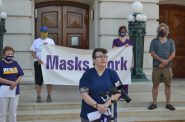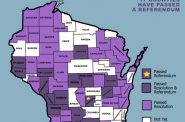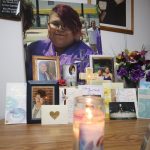The Education of Prentice McKinney
How a teenaged-boy joined the march for open housing.
Prentice McKinney is the son of parents born in the Deep South. His mother was used to people discriminating against her family because of the color of their skin. But to 16- year-old Prentice, it came as quite a shock.
“I grew up in the city,” McKinney said. “I had never seen discrimination.”
McKinney was born in Chicago and raised in Milwaukee. He says that as a child, he was like a lot of the kids he saw around him.
“I was into devilment like most kids in the ghetto with nothing to do, skipping school and that kind of thing,” McKinney said.
But at the age of 16, McKinney said things started to change. He credits his involvement in the NAACP Youth Council to the fact that Freedom House, where the group met, was one block away from his home. The Rev. James Groppi led the group in fighting for civil rights in Milwaukee during the late 1960s.
Groppi and the NAACP Youth Council spurred a protest to change the law to prohibit housing discrimination. For 200 nights, they marched across the 16th Street Viaduct, also known as the “Mason-Dixon line” of Milwaukee because it marked the border between the predominantly black North Side and predominantly white South Side.
McKinney was no stranger to housing discrimination. After his family was told they could not purchase a home on the South Side, the young McKinney was motivated by anger to learn about the issues facing his people.
“I started to find out about something called ‘land title covenants,’” McKinney said. The deeds made it legal for owners to sell their property only to whites. “That infuriated me,” he said
McKinney rose through the ranks at Freedom House, becoming a member of the Commandos, a group of 10-15 young black men whose role was to protect Groppi and the marchers from violent counter-protestors.
As a Commando, McKinney’s job was to keep the lines intact as the marchers walked across the bridge each night. The Commandos did not believe in violence, but they also did not believe in letting people take advantage of them.
“We demanded respect,” McKinney said. “We weren’t violent, but we weren’t nonviolent.”
The marchers were met with strong opposition whenever they crossed the bridge onto the South Side. Each night, crowds of angry whites would throw bricks and scream racist, vulgar remarks at the protestors.
“The police, in most cases were aggressive towards us, not aggressive towards the counter-protestors,” McKinney said.
When police had to intervene, they would face the white crowd with tear gas. But when they pulled the pin to release the tear gas, it would slip out of their hands and fall backwards on the marchers, McKinney recalled. This forced the marchers to run from the tear gas and into the white mob.
“It was 200 nights of getting arrested, fighting with the police, trying to protect the marchers, and, on occasion, going to jail,” McKinney said.
Anger kept him going all those nights, and still keeps him going today, he said. Participating in the open housing marches gave him an experience that would guide him for the rest of his life. Today, McKinney remains a political activist in the community and always asks himself what he can do to make a difference.
“It’s kind of been the story of my life,” McKinney said. “To be involved, to fight injustice, and to inspire others.”
This story was originally published by Milwaukee Neighborhood News Service, where you can find other stories reporting on eighteen city neighborhoods in Milwaukee.
50 Years After The Marches
-
Pandemic Shines Spotlight on Workers’ Struggle
 Sep 7th, 2020 by Erik Gunn
Sep 7th, 2020 by Erik Gunn
-
UW System Expects $212 million in Losses
![Van Hise Hall in the background. Photo by James Steakley (Own work) [CC BY-SA 3.0 (https://creativecommons.org/licenses/by-sa/3.0) or GFDL (http://www.gnu.org/copyleft/fdl.html)], via Wikimedia Commons](https://urbanmilwaukee.com/wp-content/uploads/2017/10/1017px-Ingraham_Van_Hise_carillon-185x122.jpg) May 8th, 2020 by Rich Kremer
May 8th, 2020 by Rich Kremer
-
51 of 72 Counties Now Back Fair Maps
 Apr 15th, 2020 by Matt Rothschild
Apr 15th, 2020 by Matt Rothschild
















